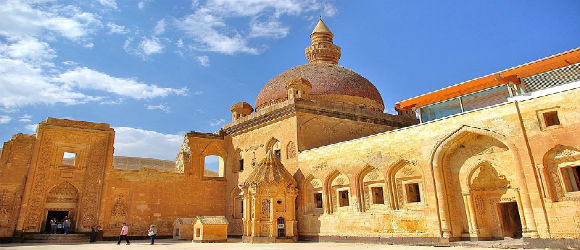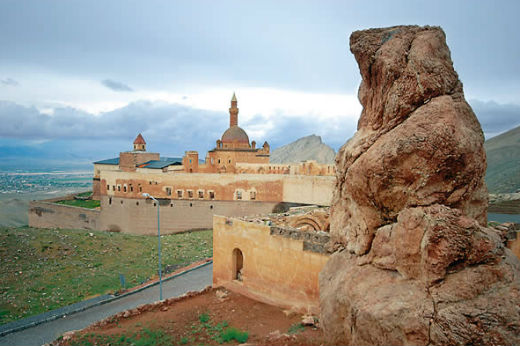In a landscape steeped in history, it greets visitors with all the majesty of the years when it dominated the city. I stand in one of Doğubeyazıt market’s narrow, congested, mysterious lanes, my eyes fixed on İshak Paşa Palace which rises at the top of a hill as if to keep an eye on the city’s every move. For a while I have trouble believing that this palace, perched here as if by mistake, belonging to neither the street where I stand, nor to the city nor the existing cultural fabric, represents the 18th century and the street where I stand the 21st.
Traces of the Seljuks
Construction of the palace began in 1685 under the rule of İshak Paşa’s father, Çolak Abdi Paşa, and was completed in 1784 when it acquired it present form with İshak Paşa’s second round of additions. The completion in 99 years of a palace begun in 1685 is among the clues to its splendor. Its protracted period of construction cannot be explained merely in terms of its splendor of course. As it changed hands, its owner’s concept of luxury changed as well, and many years were required for all the additions that had to be made before it assumed its final form.
A story worthy of a film lies behind the construction of this palace, which is equipped with heating system not unlike the central heating systems we have today. The incidents that determined the fate of this magnificent palace developed as follows:
Although the period coincided with the empire’s decline, a number of successful figures who governed on the extensive Ottoman lands were heard of by the central administration and rewarded in various ways. İshak Paşa was one of them. Following his political successes, he was first appointed to the Kars Principality and then made governor of Tiflis. The turmoil at the center was felt and used by İshak Paşa, who, as rumor has it, used a portion of the taxes he should have sent back to Istanbul to build his palace and was consequently dismissed from the governorship and exiled. According to another rumor, İshak Paşa was banished after an Iranian ambassador who had been his guest later visited Topkapı and let it be known that he regarded İshak Paşa’s palace as more beautiful. But all this may be only hearsay since historical research has turned up documents testifying to İshak Paşa’s having been governor at the time.
Standing some 5-6 kilometers from the city center, İshak Paşa Palace was the administrative center of the Ottoman subprovince of Beyazıt in its time. Spread over an area of 7,600 m2, it is distinguished from other contemporary structures not only by its classical Ottoman architecture but by its local motifs and Seljuk and Persian influences.
Golden Gate of dreams
I stand at the palace threshold and dream. I wonder how far the desire for show and ostentation can go as I try to picture the palace’s now missing gold-plated gate. I picture this gate, which was removed by the Russians, standing right in front of me and feel small and crushed under the weight of its splendor as I arrive to visit the Pasha. Before I am crushed further, I flee from the threshold and find myself in the courtyard.
İshak Paşa Palace, which boasts some of the most outstanding examples of baroque and rococo stone masonry and relief carving, dazzles the eye at every step.
Built in a style that exceeded the architectural concept of its day, İshak Paşa Palace manifests this most clearly in its heating, sewerage and water supply systems, which were not the norm for the period of its construction. The heating system in particular is awesome, based on the circulation of heated water through channels.
From Milk Fountain to Dungeon
All the structures in the palace complex are nested together around two central courtyards. A guard room stands to the left of the first courtyard, and a large fountain inscribed ‘Water and Milk Fountain’ to the right. According to various sources, water flowed from one and milk from the other of this fountain’s two spigots, from which the local residents also benefitted. It is rumored that the breasts of pregnant women and new mothers who drank water from those fountains, which reflected the power of the palace owners, would produce more milk.
Apart from its fountain and guard room, the first courtyard also has a waiting room, as well as sections that were used as dungeons. Descending a steep stairway into the gloom does not strike a person as very inviting. But to return without seeing these dungeons is out of the question, so I head down. Pitch-dark, the dungeon has a row of widely spaced windows that let in a little light, but of course these windows can only be opened from the outside.
Back to history at the Second Courtyard
Regaining the light of day, I turn immediately to the second courtyard. First I encounter the 10-meter high gate, delicately inscribed with cypress motifs. This is definitely not something to be passed over lightly. Transfixed by the cypress motifs, I stand briefly in silence before stepping into the second courtyard. Inside this courtyard is yet another courtyard, known as the ‘Selamlık’ or Men’s Quarters Courtyard. From the minute you enter the second courtyard, the palace’s spellbinding interior structures begin to show their faces: the palace mosque, a mausoleum built for Çolak Abdi Paşa and İshak Paşa, and the main building in all its glory. Such are the surprises awaiting me in the second courtyard.
Every area toured in the main building, which boasts a gigantic harem, a soup kitchen, entertainment halls, rooms for workers and guests, a library and a court of law, puts new dreams in a visitor’s pocket, with the result that those days of splendor are revived anew in every guest that comes here.
Meanwhile the interior of the mosque, practically the only palace building that has not been damaged in the devastation caused by man and nature over the centuries, is enveloped in a different beauty at each hour of the day depending on how the light falls. Its simple architecture and impressive decorations instantly purify all those who enter.
If one day you want to delve more deeply into history, indeed to touch it with your own hands, then make your way to the east. İshak Paşa Palace gives visitors far more than what is written about it or evident in photographs. Everyone who comes here leaves these history-steeped lands with memories impossible to put into words.
PROTECTIVE COVER FOR İSHAK PAŞA
A lengthy process of restoration against damage the palace has suffered from the elements is about to be completed. Severely affected by rain, snow and sunlight, the restoration of the palace’s inner buildings is being completed as plans are also being laid for a glass cover to reduce those effects to a minimum. The glass used will not only be non-breakable but will also filter out the sun’s harmful rays. Protective in purpose, the glass cover’s impact on the visual appearance of the palace will only emerge once it is in place.
WHAT TO EAT
Don’t return without sampling some of the meat dishes of Doğubeyazıt, which, thanks to its geographical features, boasts some of Turkey’s tastiest red meat. Among them you can try Abdigor köfte, or meatballs, made from beef and a local dish called ‘selekeli’, which consists of fresh goat or lamb braised on a red-hot metal plate. Both are available at restaurants on Doğubeyazıt’s market street.
WHERE TO STAY
If you’d like to tour other touristic areas in the region besides İshak Paşa Palace, you can stay at one of the certified tourist hotels in the town center. There are nine hotels in Doğubeyazıt, which is currently boosting its accommodation facilities due to an influx of tourists.


